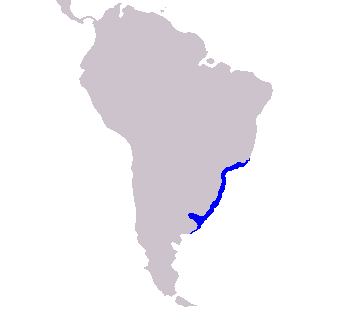
Franciscana
Order : Cetacea
Suborder : Odontoceti
Family : Platanistidae
Species : Pontoporia blainvillei
The Franciscana, la plata river dolphin is listed as Data Deficient (DD), inadequate information to make a direct, or indirect, assessment of its risk of extinction, on the IUCN Red List of Threatened Species
Franciscana habitats
Epipelagic (0-200m), Marine Neritic, Marine Oceanic, Pelagic, Permanent Rivers / Streams / Creeks (includes waterfalls) and Wetlands (inland)Some facts about the
Franciscana
Adult weight : 40.5 kg (89.1 lbs)
Female maturity :912 days
Male maturity : 912 days
Gestation : 319 days
Weaning : 319 days
Litter size : 1
Litters per year : 1
Interval between litters : 730 days
Weight at birth : 7.9 kg (17.38 lbs)
Facts about the franciscana
Binomial name Pontoporia blainvillei The La Plata Dolphin (Pontoporia blainvillei) is a river dolphin.
La Plata Dolphin range The La Plata Dolphin (Pontoporia blainvillei) is a river dolphin.
The La Plata Dolphin (Pontoporia blainvillei) is a river dolphin.
The La Plata dolphin or Franciscana (Pontoporia blainvillei) is endemic to the coastal waters of the central western South Atlantic (Brazil, Uruguay and Argentina) and one of the rarest and most poorly known South American dolphins.
© National Research Council Canada Notes: The franciscana, Pontoporia blainvillei, is a dolphin that experiences extensive incidental mortality in fisheries throughout its
Description: The Franciscana is one of the world's smallest cetaceans.
- [Oct 29, 2004] We reported previously that the major cysteine protease in embryos and larvae of the brine shrimp, Artemia franciscana, is a heterodimeric protein consisting .
The Franciscana is a [CITIES-listed Endangered Species]
LENGTH AND WEIGHT The Franciscana is one of the smallest cetaceans; average length for both males and females is 6 feet (1.
Jun 7, 2004The brine shrimp (Artemia franciscana) is tetraploid, whereas the pine sawfly (Diprion similie) has diploid males but tetraploid females.
Conservation Status: The Franciscana is common in local areas
Because no comprehensive study has been undertaken to assess the impact of fisheries on the species, franciscana is listed as "Data Deficient" in the IUCN Red Data Book.
BEHAVIOR: The Franciscana is difficult to detect for several reasons. (Full text)
In the Rio Grande do Sul coast, franciscanas are known to reproduce seasonally; births occur from October to early February (about 75% from October to December). (Full text)
Fascinating Facts: Franciscanas are the only member of the river dolphin family living in the sea.
STATUS Several hundred Franciscanas are accidentally caught in shark nets each year with past estimates as high as 1500.
Surveys (including beach surveys, visits to museum collections, interviews with local people) indicate that franciscanas are extremely rare or absent in two areas of the northern parts of their range between Macaé (southern Rio de Janeiro State) and Ubatuba (northern São Paulo State) and in southern EspÃrito Santo State (Azevedo et al.
Although considered one of the river dolphins, franciscanas are found mainly in coastal marine waters with occasional occurrences in estuaries.
When they are born, franciscanas are about 70cm (28in) long .
Franciscanas are most common in the La Plata estuary but they do not venture upstream further than Buenos Aires.
More animals beginning with F
